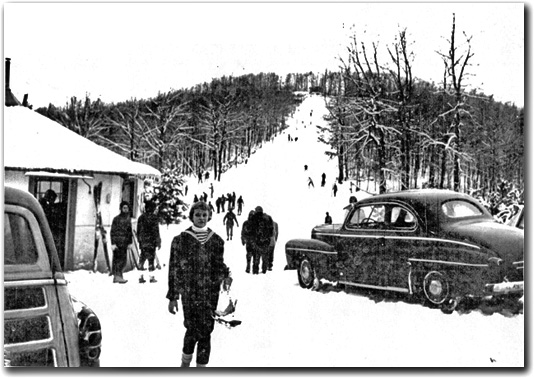
|
|
Skiing in the early 1950s at Chestnut Ridge. This photo shows the 550-foot ski slope at Chestnut Ridge, a small ski resort located near Coopers Rock State Forest in West Virginia from 1951 through 1973. During the season this photo was taken, the ski slope was open for 40 days of skiing. Photo courtesy of James Shepherd.
|
Chestnut Ridge offered a 170-foot vertical with one rope tow.
In 1993, the eleventh edition of Lost Colorado Ski Areas, a newsletter posted to the Internet newsgroup rec.skiing by Mark Wallace, included some details about Chestnut Ridge.
According to the newsletter, Chestnut Ridge operated from about 1966 to 1980. The ski area was located in Coopers Rock State Forest, about 12 miles east of Morgantown, West Virginia. The base elevation of the area was at 2,100 feet above sea level, with the top of the area at 2,270 feet.
DCSki reader Matt Kavlick tipped us off to a book titled Greater Morgantown and Its People, Volume III, published by the Dominion Post, a newspaper based out of Morgantown. The book includes historical information about the Morgantown area, and includes a photo (above) of Chestnut Ridge taken in the early 1950’s by James Shepherd. James Shepherd served as Recreation Director of the Monongalia County Consolidated Recreation Commission until June 30, 1973. In the book, the photo’s caption indicated that Chestnut Ridge offered winter activities from 1951 through 1973, when the 500-foot long slope was closed. These dates indicate that Chestnut Ridge’s lifespan may have been greater than that indicated in the Lost Colorado Ski Areas newsletter.
Thanks to the efforts of Matt Kavlick, Kelley Dlugos at The Dominion Post, and Bruce Miller, the current Park Superintendent at Chestnut Ridge Park, we received a note from James Shepherd providing permission to publish his photo above. James was in charge of the recreation commission at Chestnut Ridge in the early 1950s, and we extend thanks to him for permission to publish a great photo that provides a rare window to the history of Chestnut Ridge.
James also sent us a newspaper clipping from the January 8, 1984 issue of Panorama. In that article, author Janice DePollo provided a historical look at Chestnut Ridge. DePollo notes that the Chestnut Ridge Ski Area (and related Mountaineer Winter Sports Club) was formed by a group of Morgantown residents in the early 1950s.
“There were a bunch of boys trying to ski down the hill and miss the trees at the bottom,” James Shepherd is quoted in the article as saying. By 1953, interest had peaked and construction of a ski slope began. Members of the Mountaineer Winter Sports Club purchased a Model A Ford Engine for $25 to drive a rope tow, but according to the Panorama article, the greatest expense was the 1,200-foot long rope, which cost the club $500. The rope was driven by a large wooden wheel powered by the gas engine, resulting in a rope tow that initially ran only halfway up the vertical slope, later expanded to run the entire length of the slope. Shepherd recalls that Chestnut Ridge probably had the first rope tow in operation in the state of West Virginia.
The primary slope at Chestnut Ridge faced east/southeast, which helped limit the average snow season to 25 days. According to DePollo, club members were anxious to add a northerly slope, which would retain snow better. Two northerly-facing slopes were cut, although only one was ever in use, and apparently not for an extended period of time.
DePollo reports that the regular ski rates at Chestnut Ridge were $1 for adults and 50 cents for students. As many as 200 skiers turned out to use the facilities on Sundays, she writes.
According to Matt, the Coopers Rock State Forest currently offers two cross-country ski trails: a two-mile intermediate loop and a three-mile advanced trail.
Today, Chestnut Ridge Park offers hiking, fishing, paddle boating, swimming, camping, and other recreational activities.

Join the conversation by logging in.
Don't have an account? Create one here.